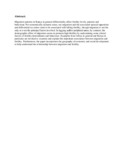| dc.contributor.author | Omondi, Charles Ochola | |
| dc.contributor.author | Ayiemba, EHO | |
| dc.date.accessioned | 2013-06-25T13:26:23Z | |
| dc.date.available | 2013-06-25T13:26:23Z | |
| dc.date.issued | 2003 | |
| dc.identifier.citation | African Population Studies vol. 18 n°1/Etude de la population africaine vol.18 n° 1, 2003 | en |
| dc.identifier.issn | https://tspace.library.utoronto.ca/bitstream/1807/1259/1/ep03007.pdf | |
| dc.identifier.uri | http://erepository.uonbi.ac.ke:8080/xmlui/handle/123456789/39790 | |
| dc.description.abstract | Migration patterns in Kenya in general differentially affect fertility levels, patterns and
behaviour. For economically dynamic areas, out-migration and the associated spousal
separation and differential sex ratios seem to be associated with falling fertility, though
migration is not the only or even the principal factor involved. In lagging and/or peripheral
areas, by contrast, the demographic effect of migration seems to promote high fertility by
undermining some critical factors of fertility determinants and behaviour. Examples from
Africa in general and Kenya in particular are invoked to examine and explain this important
association between migration and fertility. Furthermore, the paper incorporates the
geography of economic and social development to help understand the relationship between
migration and fertility. | en |
| dc.language.iso | en | en |
| dc.title | Migration and Fertility Relationship: A Case Study of Kenya | en |
| dc.type | Article | en |
| local.publisher | Department of Geography, University of Nairobi | en |
| local.publisher | Maseno University | en |


